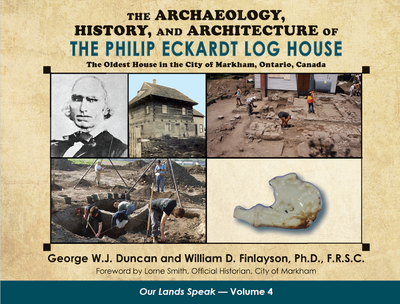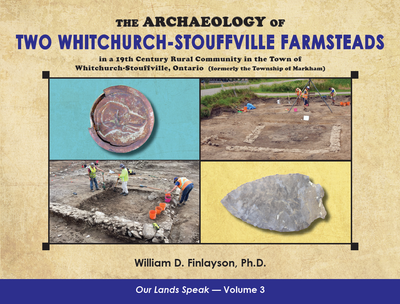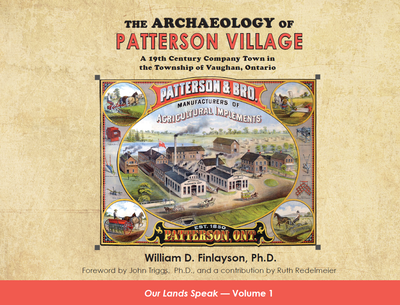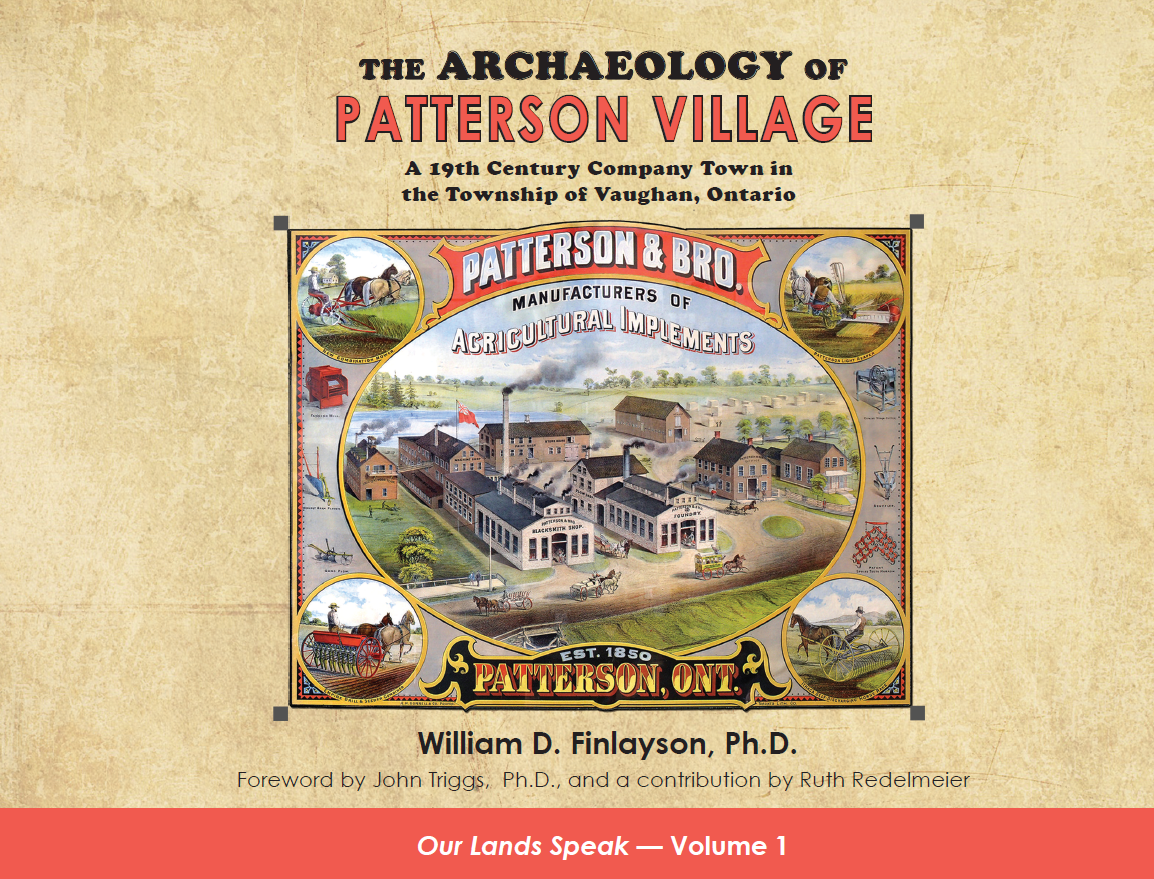100% CANADIAN OWNED & OPERATED!
The Archaeology of Patterson Village (e-book)
$29.95CAD
The Archaeology of Patterson Village, a 19th Century Company Town in the Township of Vaughan, Ontario
1
Save this product for later
Customer reviews
Reviews only from verified customers
No reviews yet. You can buy this product and be the first to leave a review.
The Archaeology of Patterson Village (e-book)
Product Details
Author(s): William D. Finlayson
Year Published: 2017
Pages: (PDF) 177 pgs., i-xiii, numerous illustrations.
Imprint: Our Lands Speak - Volume 1
Publisher: I C Publishing
ISBN: 978-927952-74-0 (e-book)
Please Note: This is a high resolution PDF with numerous illustrations. Please allow sufficient time to download.
Description
In October 2012, Michael Pozzebon, Vice-President of DG Group, a major Greater Toronto land developer, called to announce the purchase of 180 acres of prime land at the corner of Bathurst Street and Major Mackenzie Drive in the City of Vaughan. Michael requested that we conduct an archaeological assessment on a priority basis as the property development was imminent.
Little did I know that this would become one of the two largest, most complex, archaeological excavations that I have ever undertaken. Two full, and one partial field seasons were required to complete all field work and an additional two years were required to clean, catalogue, describe, and analyze the very large collection of artifacts to prepare the final report for the Ministry of Tourism, Culture and Sport. We discovered that there had been a partial assessment of the property by a previous archeological consultant and that they had delimited Patterson Village, the 19th century company town beside the Patterson & Bro. Manufacturers of Agricultural Implements, as being 1.46 hectares in size, and did not collect a single artifact.
The Ministry of Tourism, Culture and Sport defines four stages in undertaking archaeological assessments. Stage 1 is background research of existing knowledge of the property. This was done by the staff in our office. The second stage was to assess the remaining parts of the property to ensure that there were no additional sites which needed to be investigated. This work was done in November 2012 and demonstrated that Patterson Village was the only significant archaeological site on the property.
Stage 3 involved collecting the artifacts from the surface of the freshly cultivated site to determine its size and to dig test pits across those parts of the site which could not be cultivated. This work revealed that the site covered about 7.75 hectares, more than five times larger than the previous estimate.
DG Group’s plan was to develop the northern and eastern portions of the property first. To do that they needed two corridors cleared of archaeological resources to install their services to those parts of the property outside the site. Thus, our next task was to undertake the Stage 3 test excavation and the Stage 4 salvage excavation of the North-South, and East-West Service Corridors. This was started in November and completed in the spring of 2013.
Our final tasks were to complete the Stage 3 test excavation and the Stage 4 salvage excavation of the two remaining parts of the site which we called Area 1 – the Triangle, and Area 2 – the area west of the North-South Corridor.
After more than 18 months of fieldwork, our excavations revealed the presence of 18 houses, a church, a raised grain storage building, 20 pit privies, 16 box privies, six cisterns, and a well within the residential part of the village. In the western part of the village we found the boarding house with four pit privies, one box privy, and five cisterns. Our excavations investigated 334 other features in the subsoil which produced varying quantities of artifacts. The excavations produced a total of 291,911 artifacts and an additional estimated 1,113,097 artifacts of preserved plant remains from the processing of soil samples using a flotation technique.
In the fall of 2012, I met Ruth Redelmeier, whose family trust had sold the property to DG Group. Ruth had spent the previous 25 years researching both Patterson Village, and Patterson & Bro. Manufacturers of Agricultural Implements. She graciously provided a CD with copies of her research which yielded a bonanza of historical information which would not otherwise have been available. Her data has provided many significant insights into the site interpretations which would not normally have been possible.
This book is intended to provide the public with information about Patterson Village, Patterson & Bro. Manufacturers of Agricultural Implements, and the results of the archaeological excavations. Filing a 1,200 plus page licence report on such a significant site is simply not enough.
Peter Patterson was an exceptional individual who immigrated to Canada about 1850 and eventually established one of the first major manufacturers of farm equipment and also established one of the earliest company towns in Ontario.
Unlike many company towns, Patterson paid fair wages, and provided housing for both families and single men at reasonable rates. Families were provided with seeds for planting gardens near their houses, and fruit trees as a source of fresh fruit. In part, Patterson was controlling his workforce by providing quick access to the factory and improving their lives by forbidding alcohol and tobacco. His wife also checked-in with the villagers weekly to see that all was well. Thus, Peter Patterson was a paternalistic capitalist at a time when capitalism reigned with little care for the workers or their families.
Our work on DG Group land has provided a wealth of new information on Patterson Village, its residential houses, and a boarding house. While most of the Patterson & Bro. manufactory was demolished and the area redeveloped as farm buildings after closure of the factory and village, more research could be undertaken outside DG Group land. The original factory building constructed in 1856 lies within land now under ownership of the Metro Region Conservation Authority. Further, Peter Patterson’s house remains standing in its original position on a lot to the west of the factory. A search for privies on this property might provide interesting details about the content of privies used by the Patterson family compared with those of the villagers in their family residences and the boarding house.
Excerpted from William D. Finlayson’s Preface
You May Also Like

The Archaeology, History, and Architecture of the Philip Eckardt Log House (e-book)
The Archaeology, History, and Architecture of the Philip Eckardt Log House (e-book)
The Archaeology, History, and Architecture of the Philip Eckardt Log House: The Oldest House in the City of Markham, Ontario, Canada

The Archaeology of Two Whitchurch-Stouffville Farmsteads (e-book)
The Archaeology of Two Whitchurch-Stouffville Farmsteads (e-book)
The Archaeology of Two Whitchurch-Stouffville Farmsteads in a 19th Century Rural Community in the Town of Whitchurch-Stouffville, Ontario (formerly the Township of Markham)

The Archaeology of Five Queensville Farmsteads (e-book)
The Archaeology of Five Queensville Farmsteads (e-book)
The Archaeology of Five Queensville Farmsteads: a 19th Century Crossroads Community in the Township of East Gwillimbury, Ontario

The Archaeology of Five Queensville Farmsteads (paperback)
The Archaeology of Five Queensville Farmsteads (paperback)
The Archaeology of Five Queensville Farmsteads: a 19th Century Crossroads Community in the Township of East Gwillimbury, Ontario

The Archaeology of Patterson Village (paperback)
The Archaeology of Patterson Village (paperback)
The Archaeology of Patterson Village, a 19th Century Company Town in the Township of Vaughan, Ontario

The Archaeology, History, and Architecture of the Philip Eckardt Log House (paperback)
The Archaeology, History, and Architecture of the Philip Eckardt Log House (paperback)
The Archaeology, History, and Architecture of the Philip Eckardt Log House: The Oldest House in the City of Markham, Ontario, Canada

The Archaeology of Two Whitchurch-Stouffville Farmsteads (paperback)
The Archaeology of Two Whitchurch-Stouffville Farmsteads (paperback)
The Archaeology of Two Whitchurch-Stouffville Farmsteads in a 19th Century Rural Community in the Town of Whitchurch-Stouffville, Ontario (formerly the Township of Markham)
Book Bundle

Our Lands Speak Volumes 1-4 (paperback bundle)
Our Lands Speak Volumes 1-4 (paperback bundle)
Our Lands Speak, Volumes 1 - 4
Display prices in:CAD

